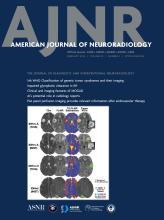Index by author
Cote-corriveau, Gabriel
- Pediatric NeuroimagingYou have accessWhite Matter Injury on Early-versus-Term-Equivalent Age Brain MRI in Infants Born PretermSriya Roychaudhuri, Gabriel Côté-Corriveau, Carmina Erdei and Terrie E. InderAmerican Journal of Neuroradiology February 2024, 45 (2) 224-228; DOI: https://doi.org/10.3174/ajnr.A8105
Desai, Amit
- FELLOWS' JOURNAL CLUBBrain Tumor ImagingOpen AccessNewly Recognized Genetic Tumor Syndromes of the CNS in the 5th WHO Classification: Imaging Overview with Genetic UpdatesAmit Agarwal, Girish Bathla, Neetu Soni, Amit Desai, Pranav Ajmera, Dinesh Rao, Vivek Gupta and Prasanna VibhuteAmerican Journal of Neuroradiology February 2024, 45 (2) 128-138; DOI: https://doi.org/10.3174/ajnr.A8039
In this review of the new 5th edition of the WHO classification, the authors focus on imaging and genetic characteristics of 8 new syndromes: Elongator protein complex-medulloblastoma syndrome, BRCA1-associated protein 1 tumor-predisposition syndrome, DICER1 syndrome, familial paraganglioma syndrome, melanoma-astrocytoma syndrome, Carney complex, Fanconi anemia, and familial retinoblastoma.
Dillon, Henry
- Artificial IntelligenceOpen AccessA Radiomic “Warning Sign” of Progression on Brain MRI in Individuals with MSBrendan S. Kelly, Prateek Mathur, Gerard McGuinness, Henry Dillon, Edward H. Lee, Kristen W. Yeom, Aonghus Lawlor and Ronan P. KilleenAmerican Journal of Neuroradiology February 2024, 45 (2) 236-243; DOI: https://doi.org/10.3174/ajnr.A8104
Dobrocky, Tomas
- Neurovascular/Stroke ImagingOpen AccessValue of Immediate Flat Panel Perfusion Imaging after Endovascular Therapy (AFTERMATH): A Proof of Concept StudyAdnan Mujanovic, Christoph C. Kurmann, Michael Manhart, Eike I. Piechowiak, Sara M. Pilgram-Pastor, Bettina L. Serrallach, Gregoire Boulouis, Thomas R. Meinel, David J. Seiffge, Simon Jung, Marcel Arnold, Thanh N. Nguyen, Urs Fischer, Jan Gralla, Tomas Dobrocky, Pasquale Mordasini and Johannes KaesmacherAmerican Journal of Neuroradiology February 2024, 45 (2) 163-170; DOI: https://doi.org/10.3174/ajnr.A8103
Early, Heather
- FELLOWS' JOURNAL CLUBPediatric NeuroimagingYou have accessClinical and Imaging Findings in Children with Myelin Oligodendrocyte Glycoprotein Antibody Associated Disease (MOGAD): From Presentation to RelapseElizabeth George, Jeffrey B. Russ, Alexandria Validrighi, Heather Early, Mark D. Mamlouk, Orit A. Glenn, Carla M. Francisco, Emmanuelle Waubant, Camilla Lindan and Yi LiAmerican Journal of Neuroradiology February 2024, 45 (2) 229-235; DOI: https://doi.org/10.3174/ajnr.A8089
This study characterizes the CNS imaging manifestations of pediatric MOGAD. The authors also identify the clinical and imaging variables associated with relapse. There is an age-dependent imaging phenotype at presentation and first relapse, and older age at presentation is associated with shorter time to relapse.
Ellingson, Benjamin M.
- EDITOR'S CHOICEBrain Tumor ImagingYou have accessQuantification of T2-FLAIR Mismatch in Nonenhancing Diffuse Gliomas Using Digital SubtractionNicholas S. Cho, Francesco Sanvito, Viên Lam Le, Sonoko Oshima, Ashley Teraishi, Jingwen Yao, Donatello Telesca, Catalina Raymond, Whitney B. Pope, Phioanh L. Nghiemphu, Albert Lai, Timothy F. Cloughesy, Noriko Salamon and Benjamin M. EllingsonAmerican Journal of Neuroradiology February 2024, 45 (2) 188-197; DOI: https://doi.org/10.3174/ajnr.A8094
The T2-FLAIR mismatch sign on MR imaging, usually determined by visual assessment, is a highly specific imaging biomarker of IDH-mutant astrocytomas. The authors of this study quantified the degree of T2-FLAIR mismatch in nonenhancing diffuse gliomas. Thresholds of ≥42% T2-FLAIR mismatch volume classified IDH-mutant astrocytoma with a specificity/sensitivity of 100%/19.6% (TCIA) and 100%/31.6% (institutional). They also found that grades 3–4 compared with grade 2 IDH-mutant astrocytomas (P<.05) had a higher percentage T2-FLAIR mismatch volume.
Emmer, Bart J.
- NeurointerventionYou have accessTransarterial Embolization of Anterior Cranial Fossa Dural AVFs as a First-Line Approach: A Single-Center StudyCarl A. J. Puylaert, René van den Berg, Bert A. Coert and Bart J. EmmerAmerican Journal of Neuroradiology February 2024, 45 (2) 171-175; DOI: https://doi.org/10.3174/ajnr.A8092
Erdei, Carmina
- Pediatric NeuroimagingYou have accessWhite Matter Injury on Early-versus-Term-Equivalent Age Brain MRI in Infants Born PretermSriya Roychaudhuri, Gabriel Côté-Corriveau, Carmina Erdei and Terrie E. InderAmerican Journal of Neuroradiology February 2024, 45 (2) 224-228; DOI: https://doi.org/10.3174/ajnr.A8105
Filippi, C.G.
- Neuroimaging Physics/Functional Neuroimaging/CT and MRI TechnologyYou have accessRecommended Resting-State fMRI Acquisition and Preprocessing Steps for Preoperative Mapping of Language and Motor and Visual Areas in Adult and Pediatric Patients with Brain Tumors and EpilepsyV.A. Kumar, J. Lee, H.-L. Liu, J.W. Allen, C.G. Filippi, A.I. Holodny, K. Hsu, R. Jain, M.P. McAndrews, K.K. Peck, G. Shah, J.S. Shimony, S. Singh, M. Zeineh, J. Tanabe, B. Vachha, A. Vossough, K. Welker, C. Whitlow, M. Wintermark, G. Zaharchuk and H.I. SairAmerican Journal of Neuroradiology February 2024, 45 (2) 139-148; DOI: https://doi.org/10.3174/ajnr.A8067
Finkelstein, Alan
- EDITOR'S CHOICENeuroimaging Physics/Functional Neuroimaging/CT and MRI TechnologyYou have accessDiffusion-Weighted Imaging Reveals Impaired Glymphatic Clearance in Idiopathic Intracranial HypertensionDerrek Schartz, Alan Finkelstein, Nhat Hoang, Matthew T. Bender, Giovanni Schifitto and Jianhui ZhongAmerican Journal of Neuroradiology February 2024, 45 (2) 149-154; DOI: https://doi.org/10.3174/ajnr.A8088
The diffusivity along the cerebral perivascular spaces (DTI-ALPS technique) and lateral association and projection fibers in patients with IIH were compared with normal controls. Using the degree of diffusivity as a surrogate for glymphatic function, IIH patients were shown to have a significantly lower glymphatic clearance compared with controls (P=.005), with a significant association between declining glymphatic clearance and increasing Frisen papilledema grade (P=.046).








